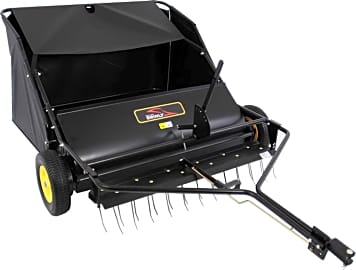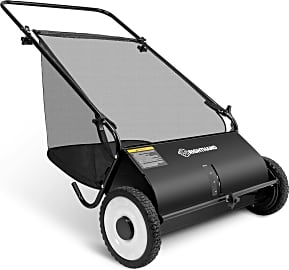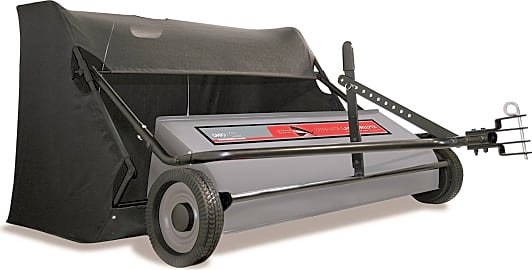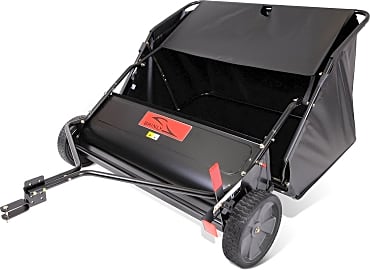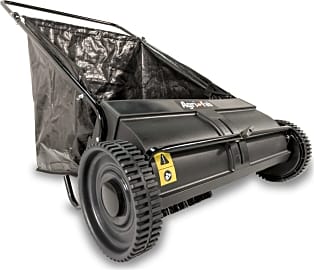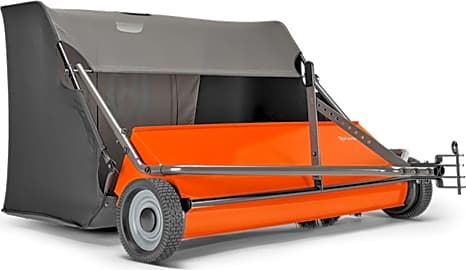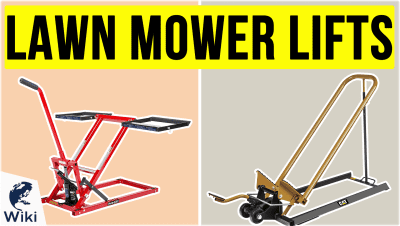The 8 Best Lawn Sweepers

This wiki has been updated 42 times since it was first published in January of 2016. Got leaves strewn all over your property? Put down that back-breaking rake and try one of these lawn sweepers instead. They'll make light work of picking up twigs, grass clippings, pine needles, and virtually anything else spoiling your perfect landscaping. We've included uncomplicated push units and more robust pull-behind models that attach to a lawn tractor, for larger properties. When users buy our independently chosen editorial selections, we may earn commissions to help fund the Wiki.
Editor's Notes
October 09, 2020:
When choosing a lawn sweeper, the two basic options are a unit that attaches to the back of a riding mower or tractor, or a smaller, walk-behind model that requires more effort, but still saves one a lot of back-breaking time spent raking.
For this update we added another walk-behind option in the same style as the Agri-Fab Push. The Right Hand Push is more durable, with a stainless steel body, vs the plastic Agri-Fab, but the Agri-Fab still may be a better choice for someone who wants a lighter weight model to push.
We also added the Brinly Tow-Behind for its versatility as a dethatcher and sweeper. While it makes the unit a lot more expensive than sweepers with only one purpose, it will save some storage space in the garage.
May 03, 2019:
If your lawn is your pride and joy, we still think you can rely on models from Agri-Fab and Brinly to help you keep it immaculately groomed. Both offer robust pull-behind units in the 40-inch range, which should be appropriate for the majority of users. One note, though: the Brinly is not known for being easy to assemble, so be prepared to put in some time and effort. We also added the Craftsman Hi-Speed as another worthy option, especially since it provides an admirable 8.5-to-1 brush to wheel ratio. For those who need to get rid of moss and thatch, we have kept the Sun Joe Dethatcher, which has a handy collection bag and robust steel tines. It does have quite a number of plastic parts, however, so you won't be able to treat it too roughly. And, finally, we decided to add the Agri-Fab Push for those folks who don't have a lawn tractor. It will save some labor over raking, but if you have a bumpy or hilly lawn, it can feel quite hard to push.
A Clean Sweep: Get Yourself A Lawn Sweeper
And second, a human powered lawn sweeper is a remarkably quiet device.
If you pine for a yard free of pine needles or loathe the leaves left behind after a blustery fall day, then a lawn sweeper is the perfect ally in your quest for a crisp looking property. What autumn leaves or the lawn mower leave behind, a lawn sweeper can pick up, no raking required.
First let's look at a few of the reasons many people have chosen to purchase and use a lawn sweeper, then we'll look at the different types of units available. We'll discuss the lawn sweeper vs. the classic rake below, but a rake is not the only landscaping and property maintenance tool a lawn sweeper can supplant.
Lawn sweepers offer a great alternative to that other common landscaping tool, the leaf blower, for two primary reasons. First, a lawn sweeper can easily scoop up and gather even wet leaves or clumps of damp grass, items often too heavy or matted down for a leaf blower to lift or move. And second, a human powered lawn sweeper is a remarkably quiet device. You won't wake the neighborhood (or disturb the barbecue next door) by pushing a lawn sweeper about, whereas many gas powered leaf blowers often register at a volume of 70 to 75 decibels even when their noise is measured from fifty feet away.
There are two distinct types of lawn sweepers, and it's unlikely you will find both suitable for your property. The first type is a push behind option that is human powered and about the size if a standard lawn mower. These lawn sweepers make short work of the leaves and other natural debris littering a standard sized residential property, usually clearing a swath of about the same width a rake would cover with each pass. If you own or care for a single family residence (or a small business or apartment complex ringed by a moderate plot of property) that you want to keep looking clean and clear of fallen leaves, these affordable units are ideal.
The other type of lawn sweeper is decidedly more industrial in scale. In fact, you will need to use a tractor or riding lawn mower in order to use this next type of lawn sweeper: a pull behind lawn sweeper can gather many cubic feet of leaves (and other material) before its storage chamber needs to be emptied, allowing you to quickly clean up large areas of lawn. There is the obvious limitation of a required vehicle for use of these large sweepers, but if you already own or care for a property meriting such machinery, a lawn sweeper is a fine addition to your hardware.
The Lawn Sweeper Vs. The Rake
A lawn sweeper can save its user time and energy as he or she cleans up a property by reliably gathering loose debris of myriad types. It also out performs most other types of lawn cleaning device, such as the aforementioned leaf blower. Whereas a lawn mower can pick up much of the grass it cuts, it invariably leaves behind scattered bits of grass blades. While a rake intended for leaves will indeed catch most fallen leaves, it won't get those bits of grass or other smaller bits of organic material. And even after you gather a heavy pile of leaves, trimmings, twigs, and more, you still have to scoop it into garbage cans or bags.
While a rake intended for leaves will indeed catch most fallen leaves, it won't get those bits of grass or other smaller bits of organic material.
That also says nothing about the effort required to use a basic rake, which can be a fatigue- and soreness-inducing undertaking, especially if you have a large property. It might come as a surprise to learn this statistic, but in fact each year as many as 38,000 Americans are injured by the process of raking leaves. The United States Consumer Products Safety Commission (or CSPC as it is usually known) reports that these injuries come in a variety of forms, with lower back and shoulder injuries being the most common.
Joint damage can also easily occur as a person overextends their reach on a long rake stroke or when hefting heavy bags or trash cans laden with leaves. (There is no reliable data available on the tragicomic tableau presented by a person stepping on a rake's head only to have the handle crash into his or her hapless face.)
Raking requires at least a moderate level of physical fitness, whereas a lawn sweeper can be safely pushed by almost anyone able to walk with stability. Even a slowly pushed lawn sweeper will still catch leaves and the debris. And controlling a lawn sweeper attached to a tractor or riding mower is even easier.
A Fine Source Of Rich Compost
Using a lawn sweeper presents one with the opportunity to load up a compost pile (or rotating compost bin) with remarkable ease and in less time than he or she would have imagined possible. This is true thanks to the balance of materials a properly established and maintained compost mixture requires.
This is true thanks to the balance of materials a properly established and maintained compost mixture requires.
Efficient and productive composting requires a mixture that balances the right proportion of carbon and nitrogen. This is often referred to as the C:N ratio by specialists. The ideal balance is approximately 25 parts carbon to one part nitrogen. Carbon comes from material such as straw, natural sawdust, paper free of dyes or preservatives, and of course fallen and dried deciduous leaves. Good sources of nitrogen include things like vegetable and fruit scraps, coffee grinds, and green grass clippings.
Therefore one of the best ways to quickly load up a compost bin with top quality carbon and nitrogen balanced material is to run your lawn sweeper across a grassy yard covered with fallen autumn leaves. The high volume of leaves the sweeper collects and the lower volume of grass it catches in the form of snapped blades (or bits the mower left behind earlier) will often approximate that 25:1 ration your compost pile needs.


